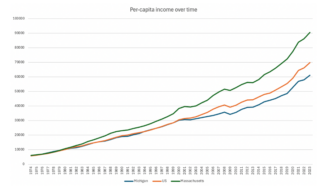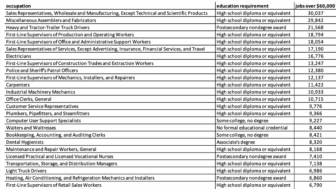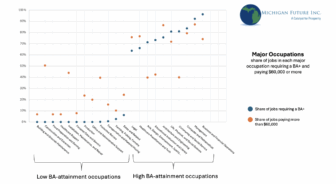
Over three decades of rigorous data analysis has taught us one fundamental lesson: This is an economy where talent attracts capital. Where young talent goes, high-growth, high-wage, knowledge-based enterprises follow, expand, and are created. The new path to prosperity is concentrated talent.
After being one of the most prosperous places on the planet for most of the 20th Century Michigan is now a low-prosperity state. Thirty ninth in per capita income. The main reason is that too many Michigan jobs are low wage. Six in ten Michigan jobs pay less than what it takes to be a middle class household of three. Michigan needs a new high-wage economic development strategy.
That is why the new Michigan Talent Partnership program is so important. It is a paradigm-altering approach to economic development. The initiative–almost certainly for the first time ever in Michigan–is explicitly designed to grow Michigan high-wage jobs by creating places where young talent wants to live.
Michigan Future has long advocated for placemaking as an economic development priority. Why? Because high per capita income states are characterized by being over-concentrated in both knowledge-based industries and adults with a B.A. or more. The two go together because college educated talent is the asset that matters most to knowledge-based employers.
Talent attracts capital and quality of place attracts talent. Attracting and retaining highly-educated young people is the state’s primary economic imperative – both keeping the young talent that grows up here, and then attracting young talent from any place on the planet.
This requires economic development policies squarely focused on creating the kinds of places where highly-educated young people want to live and work. The data show that highly-educated young people are increasingly concentrating in regions that are first and foremost transit rich and offer multiple vibrant central city neighborhoods that are high-density, high-amenity, walkable and have an active street life
In the Great Lakes Chicago is, by far, the leading young talent magnet city. 309,050 25-34 year olds with a B.A. call Chicago home. Chicago anchors a high-prosperity, knowledge economy concentrated region. (Combined the cities of Detroit, Grand Rapids, Ann Arbor and Lansing have 65,501 25-34 year olds with a B.A.)
And many of the Chicago young professionals live in the kind of transit-rich, high-amenity neighborhoods the Michigan Talent Partnership is designed to create. Chicago has 69 census tracts with at least 1,000 young professional residents. And another 396 census tracts with between 250 and 1,000.
By contrast combined the cities of Detroit, Grand Rapids, Ann Arbor and Lansing have no census tracts with 500 or more young professional residents. And only four with more than 250.
The Michigan Talent Partnership will provide grants to support the development of talent-magnet neighborhoods in Michigan’s central cities. The initiative has the twin goals of:
- Addressing the economic development imperative of increasing Michigan’s population of young talent by creating transit-rich, high-density, high-amenity, walkable, vibrant street life neighborhoods or districts.
- Creating business ownership opportunities for local residents.
The $25 million dollar initiative will fund transformational public space development projects in central city neighborhoods or geographically concentrated districts. Grants will be substantial to support transformational efforts and will require significant matching support from local sources.
Grant funds must be spent in a concentrated geographic area and the funds are for the public spaces in the neighborhood, not buildings. The focus of these projects is walkable urban design, centered on creating vibrant street life. Projects supported by this fund will be comprehensive neighborhood/district-wide plans, rather than discrete initiatives centered on a particular building or parcel, designed for walkability, density, vibrant street life and business opportunities for local residents.
Eligible projects must assist and support existing businesses, seek to protect existing local business investment and provide opportunities for local residents to start new ventures.
The Michigan Talent Partnership is a breakthrough first step in creating the kind of places that concentrate young talent. Over the long term the goal should be, that in addition to funding from this grant program, grant winners have access to funding from other state departments and agencies with built environment funding programs. Providing substantial funding for public spaces that include walkable streets, parks and outdoor recreation and the arts––particularly arts on the street.







